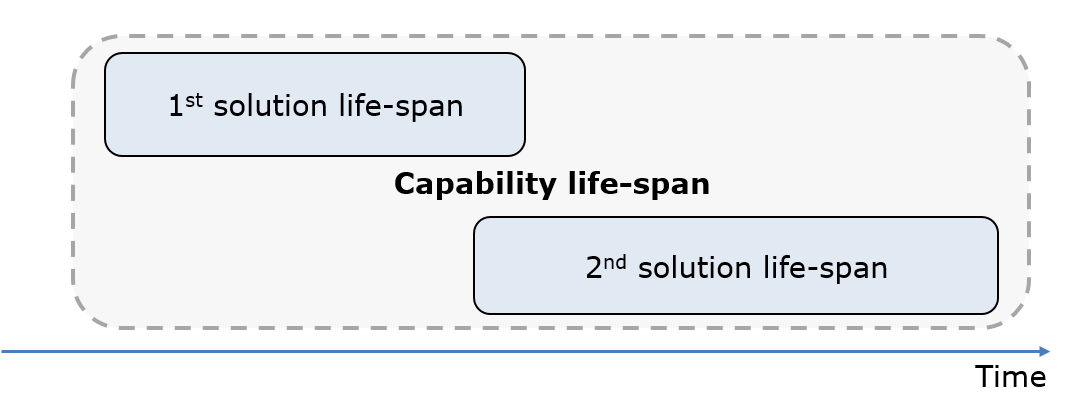This is an explanation of relationships between some roles in the enterprise architecture (inspired by http://grahamberrisford.com/00/Architect%20roles%20-%20by%20level%20and%20domain.htm ). A background description about Enterprise Architecture (EA) can be found in http://improving-bpm-systems.blogspot.ch/2013/06/entarch-basics-in-for-dummies-style.html
I think there are three dimensions (each of them has different type of partition) which are necessary for separation of enterprise architectural roles:
1) “Business domain span” – nested partition into the whole enterprise, business domain, business unit, etc.
2) “Architecture span”– mutually exclusive partition into business architecture, process architecture, information architecture, application architecture, data architecture, technology architecture, security architecture, etc.
Note: EA is responsible for the synergy between all other architectures.
3) “Time span” – partially overlapping partition into enterprise life-span, solution life-span, technology life-span (e.g. client-server, SOA), tool life-span, platform life-span, etc.
Usually, a solution (a unit of deployment) may have several versions and each version is implemented as a project (see illustration below).
Usually, there is an architect in "project 1", but very rarely he/she is actually the "solution architect" because "project 1" is just the tip of the iceberg in the whole solution life-span. Sure, some projects are just BAU for small modifications.
A few consecutive solutions may form (rather implicitly) a capability (see illustration below).
A platform usually has a few primary tools (with their own life-spans) and several overlapping in time solutions (see illustration below). See about platforms - http://improving-bpm-systems.blogspot.ch/search/label/PEAS
Enterprise architect:
- Business domain span = the whole enterprise
- Architecture span = all architectures TOGETHER
- Time span = enterprise life-span
Enterprise application architect:
- Business domain span = the whole enterprise
- Architecture span = application architectural domain
- Time span = enterprise life-span
- Business domain span = usually a particular business domain or unit
- Architecture span = a few architectures (which are critically related to the solution) TOGETHER
- Time span = solution life-span (usually a big project to deliver the first version and, optionally, several smaller evolution projects)
- Business domain span = may be the whole enterprise or a particular business domain or a few domains
- Architecture span = a few architectures (which are critically related to the platform) TOGETHER
- Time span = platform life-span
- Business domain span = the whole enterprise
- Architecture span = partially on technology and application architectures
- Time span = SOA as a particular architectural style usage in a particular enterprise
- Business domain span = the whole enterprise
- Architecture span = partially on technology, data, application and business architectures
- Time span = BPM as a particular methodology and application architecture usage in a particular enterprise
Supply-chain architect:
- Business domain span = supply-chain as the business domain
- Architecture span = all related architectural domains TOGETHER
- Time span = business domain life-span
- Business span = integration between several business domains
- Architecture span = all related architectural domains TOGETHER
- Time span = enterprise (or its particular business model) life-span
Solutions, platforms and capabilities may span several business domains as shown in illustration below. Sometimes, the architect for "Solution 1" is called "enterprise solution architect".
In general, a solution architect must follow all rules, standards, norms from all other architectures (relevant to a particular solution implemented in a particular project) unless explicitly specified and agreed up-front. Often a project architect is too limited by a project manager to address the real complexity of a solution. Application, domain and enterprise architects must help such a project and the PMO (see http://improving-bpm-systems.blogspot.ch/2011/01/relationships-between-ea-and-pmo.html ).
AS










No comments:
Post a Comment